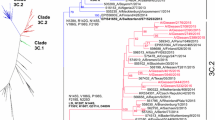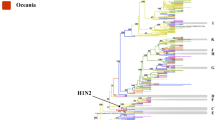Abstract
We studied the genetic and epidemic characteristics of influenza A (H3N2) viruses circulated in human in Fujian Province, south of China from 1996 to 2004. Phylogenetic analysis was carried out for genes encoding hemagglutinin1 (HA1) of influenza A virus (14 new and 11 previously reported reference sequences). Our studies revealed that in the 8 flu seasons, the mutations of HA1 genes occurred from time to time, which were responsible for about four times of antigenic drift of influenza H3N2 viruses in Fujian, China. The data demonstrated that amino acid changes were limited to some key codons at or near antibody binding sites A through E on the HA1 molecule. The changes at the antibody binding site B or A or sialic acid receptor binding site 226 were critical for antigenic drift. But the antigenic sites might change and the key codons for antigenic drift might change as influenza viruses evolve. It seems important to monitor new H3 isolates for mutations in the positively selected codons of HA1 gene in south of Asia.
Similar content being viewed by others
References
Plotkin J B, Dushoff J, Levin S A. Hemagglutinin sequence clusters and the antigenic evolution of influenza A virus. Proc Natl Acad Sci USA, 2002, 99(9): 6263–6268,11972025, 10.1073/pnas.082110799, 1:CAS:528:DC%2BD38XjslWnsb0%3D
Underwood P A. Map** of antigenic changes in the haemagglutinin of Hong Kong influenza (H3N2) strains using a large panal of monoclonal antibodies. J Gen Virol, 1982, 62: 153–169,6182265, 1:CAS:528:DyaL38XlvFKlsLs%3D, 10.1099/0022-1317-62-1-153
Wiley D C, Wilson I A. Structural identification of the antibody-binding sites of Hong Kong influenza haemagglutinin and their involvement in antigenic variation. Nature, 1981, 289(29): 373–378,6162101, 10.1038/289373a0, 1:CAS:528:DyaL3MXhvFSjtbw%3D
Wilson I A, Skehel J J, Wiley D C. Structure of the haemagglutinin membrane glycoprotein of influenza virus at 3Å resolution. Nature, 1981, 289(29): 366–373,7464906, 10.1038/289366a0, 1:CAS:528:DyaL3MXhvFSjtb8%3D
Wilson I A, Cox N J. Structural basis of immune recognition of influenza virus hemagglutinin. Annu Rev Immunol, 1990, 8: 737–771,2188678, 10.1146/annurev.iy.08.040190.003513, 1:CAS:528:DyaK3cXkslGqsb8%3D
Bush R N, Bender C A, Subbarao K, et al. Predicting the evolution of human influenza A. Science, 1999, 286(3): 1921–1925,10583948, 10.1126/science.286.5446.1921, 1:CAS:528:DyaK1MXnvFSit7k%3D
Weis W, Brown J H, Cusack S, et al. Structure of the influenza virus haemagglutinin complexed with its receptor, sialic acid. Nature, 1988, 333(2): 426–431,3374584, 10.1038/333426a0, 1:CAS:528:DyaL1cXksFSnsLs%3D
Fitch W M, Bush R M, Bender C A, et al. Long term trends in the evolution of H(3) human influenza type A. Proc Natl Acad Sci USA, 1997, 94: 7712–7718, 9223253, 10.1073/pnas.94.15.7712, 1:CAS:528:DyaK2sXksl2nsL0%3D
Plotkin J B, Dushoff J. Codon bias and frequency-dependent section on the hemagglutinin epitopes of influenza A virus. Proc Natl Acad Sci USA, 2003, 100(12): 7152–7157,12748378, 10.1073/pnas.1132114100, 1:CAS:528:DC%2BD3sXkslOnu7o%3D
**u W Q, Yang S Q, Lü S F, et al. Influenza surveillance of some surveillance sites in Fujian Province, China from January 2001 to December 2002. ELSEVIER International Congress Series, 2004, 1263: 255–258,10.1016/j.ics.2004.02.123
Zhang Y, Wen L Y, Li Z, et al. Antigenic and genetic characterizations of group A influenza virus (H3N2) circulated in men in China during 2000–2002. Chin J Exp Clin Virol, 2004, 18(1): 16–19
Sengal M S, Bye J M, Sambrook J F, et al. Disulfide bond formation during the folding of influenza virus hemagglutinin. J Cell Biol, 1992, 118: 227–244,10.1083/jcb.118.2.227
Struck D K, Lennarz W J, Brew K. Primary structural requirements for the enzymatic formation of the N-glycosidic bond in glycoproteins. J Biol Chem, 1978, 253: 5786–5794,670230, 1:CAS:528:DyaE1cXlslGis7w%3D
Nakajima K, Nobusawa E, Tonegawa K, et al. Restriction of amino acid change in influenza A virus H3HA: Comparison of amino acid changes observed in nature and in vitro. J Virol, 2003, 77(18):10088–10098,12941919, 10.1128/JVI.77.18.10088-10098.2003, 1:CAS:528:DC%2BD3sXntFSht70%3D
** H, Zhou H, Liu H, et al. Two residues in the hemagglutinin of A/Fujian/411/02-like influenza viruses are responsible for antigenic drift from A/Panama/2007/99. Virology, 2005, 336(1): 113–119,15866076, 10.1016/j.virol.2005.03.010, 1:CAS:528:DC%2BD2MXjslKiu70%3D
Sato K, Morishita T, Nobusawa E, et al. Amino-acid change on the antigenic region B1 of H3 haemagglutinin may be a trigger for the emergence of drift strain of influenza A virus. Epidemol Infect, 2004, 132(3): 399–406,10.1017/S0950268803001821, 1:CAS:528:DC%2BD2cXjvV2mt7g%3D
Nobusawa E, Nakajima K. Amino acid substitution at position 226 of the hemagglutinin molecule of influrnza (H1N1) virus affects receptor binding activity but not fusion activity. Virology, 1988, 167: 8–14,2460997, 10.1016/0042-6822(88)90048-7, 1:CAS:528:DyaL1M**tVSrtQ%3D%3D
Lu B, Zhou H, Ye D, et al. Improvement of influenza A/Fujian/411/02 (H3N2) virus growth in embryonated chicken eggs by balancing the hemagglutinin and neuraminidase activities, using reverse genetics. J Virol, 2005, 79(11): 6763–6771,15890915, 10.1128/JVI.79.11.6763-6771.2005, 1:CAS:528:DC%2BD2MXksFKhu7w%3D
Daum L T, Shaw M W, Klimov A I, et al. Influenza A (H3N2) outbreak, Nepel. Emerg Infect Dis, 2005, 11(8): 1186–1191
Shu Y L, Zhang Y, Wen L Y, et al. Antigenic and genetic study of hemagglutinin gene of influenza virus (H3N2) circulated in China in 2004. Chin J Exp Clin Virol, 2005, 19(4): 362–265,1:CAS:528:DC%2BD2sXmvVKgtQ%3D%3D
Both G W, Sleigh M J, Cox N J, et al. Antigenic drift in influenza virus H3 hemagglutinin from 1968 to 1980: Multiple evolutionary pathways and sequential amino acid changes at key antigenic sites. J Virol, 1983, 48(1): 52–60,6193288, 1:CAS:528:DyaL3sXlsFejt7o%3D
Author information
Authors and Affiliations
Corresponding author
Additional information
Supported by the grant of WHO influenza surveillance
Rights and permissions
About this article
Cite this article
**u, W., Wen, Y., Shen, X. et al. Molecular evolution of influenza A (H3N2) viruses circulated in Fujian Province, China during the 1996–2004 period. SCI CHINA SER C 51, 373–380 (2008). https://doi.org/10.1007/s11427-008-0050-8
Received:
Accepted:
Published:
Issue Date:
DOI: https://doi.org/10.1007/s11427-008-0050-8




